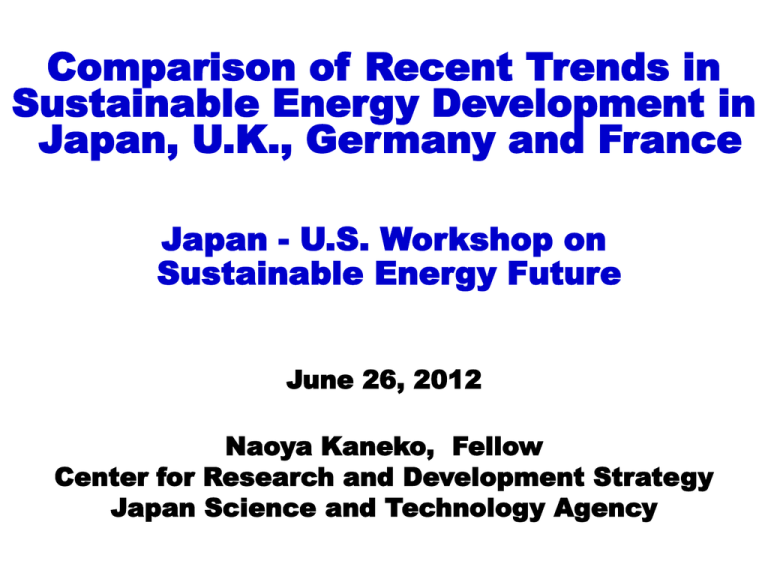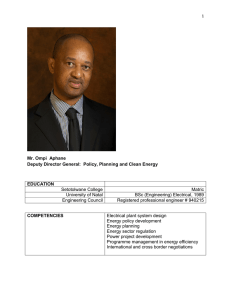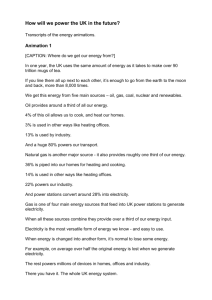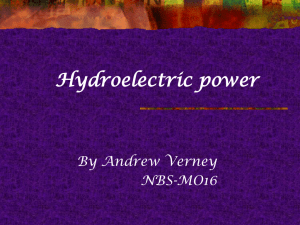
Comparison of Recent Trends in
Sustainable Energy Development in
Japan, U.K., Germany and France
Japan - U.S. Workshop on
Sustainable Energy Future
June 26, 2012
Naoya Kaneko, Fellow
Center for Research and Development Strategy
Japan Science and Technology Agency
Trends & Movements in Japan
1-1. Past Stream; Vision & Strategy for Research
▼Council for Science and Technology Policy
(CSTP)/3rd Science and Technology Basic
Plan 【from 2006 to 2010】
●Environment ; One of “four priority fields to be promoted”
●Energy ; One of “four fields to be promoted”
▼Cabinet/Cool Earth 50 (in May of 2007)
●Setting a target of “cutting greenhouse gas emissions
by half, until 2050”
Japan Science and Technology Agency All Rights Reserved.
2
1-2. Past Stream; Vision & Strategy for Research
▼Ministry of Economy, Trade and Industry
(METI)/Cool Earth Energy Innovative
Technology Plan (in March of 2008)
●Selection of 21 categories for technology innovation,
that should be given higher priority
▼Power Generation/Transmission
1)High-Efficiency Natural Gas Fired Power Generation
2)High-Efficiency Coal Fired Power Generation
3)Carbon Dioxide Capture and Storage
4)Innovative Photovoltaic Power Generation
5)Advanced Nuclear Power Generation
6)High-Efficiency Superconducting Power Transmission
Japan Science and Technology Agency All Rights Reserved.
3
1-3. Past Stream; Vision & Strategy for Research
▼Transportation
7)Intelligent Transport System
8)Fuel Cell Vehicle
9)Plug-in Hybrid Vehicle/Electric Vehicle
10)Production of Transport Biofuel
▼Industry
11)Innovative Iron and Steel Making Process
12)Innovative Material, Production and Processing Technology
Japan Science and Technology Agency All Rights Reserved.
4
1-4. Past Stream; Vision & Strategy for Research
▼Commercial/Residential
13)High-Efficiency House and Building
14)Next-Generation High-Efficiency Lighting
15)Ultra High-Efficiency Heat Pump
16)Stationary Fuel Cell
17)High-Efficiency Information Device and System
18)HEMS/BEMS/Local-Level EMS
▼Cross-Cutting
19)High-Performance Power Storage
20)Power Electronics
21)Hydrogen Production, Transport and Storage
Japan Science and Technology Agency All Rights Reserved.
5
1-5. Past Stream; Vision & Strategy for Research
▼CSTP/Low Carbon Technology Plan (in May of
2008)
●R&D Road Map for the target of “cutting greenhouse gas
emissions by half, until 2050”
●Key technologies with a significant reduction effect,
as of necessary countermeasures “at the time range of
around by 2030”
▼Energy Supply Side
・Advanced Use of Light-Water Reactors
・High-Efficiency Fired Power Generation (Coal and Natural
Gas)
Japan Science and Technology Agency All Rights Reserved.
6
1-6. Past Stream; Vision & Strategy for Research
▼Energy Demand Side
・Hybrid Vehicle
・Plug-In Hybrid Vehicle
・Electric Vehicle
・Fuel Cell Vehicle
・High-Efficiency Heat Pump
・High-Efficiency Home Electronics and Information Devices
Japan Science and Technology Agency All Rights Reserved.
7
1-7. Past Stream; Vision & Strategy for Research
●Key technologies with a significant reduction effect,
as of necessary countermeasures “at the time range of
after 2030”
▼Energy Supply Side
・Nuclear Power Generation (Next Generation Light-Water
Reactors and Fast Breeder Reactor and Its Fuel Cycle
Technology)
・Third Generation Photovoltaic Cells
・Hydrogen Production Technology
▼Energy Demand Side
・Hydrogen Reduction Iron and Steel Making Process
Japan Science and Technology Agency All Rights Reserved.
8
2-1. Past Stream; Recent Movements for Energy
▼Ministry of Economy, Trade and Industry
(METI)/Basic Energy Plan (in June of 2010)
▼Council for Science and Technology Policy
(CSTP)/4th Science and Technology Basic
Plan 【from 2011 to 2015】
●Green Innovation (Innovation for Energy &
Environment)
●Life Innovation (Innovation for Life Sciences)
Japan Science and Technology Agency All Rights Reserved.
9
2-2. Past Stream; Recent Movements for Energy
▼Cabinet Secretariat, National Policy Unit, Energy
and Environment Council/Innovative Strategy
for Energy and Environment (around Summer of
2012)
▼Ministry of Economy, Trade and Industry
(METI), Agency for Natural Resources and
Energy, Advisory Committee for Natural
Resources and Energy/Basic Energy Plan to be
revised (around Summer of 2012)
Japan Science and Technology Agency All Rights Reserved.
10
Current Situations in Japan
3. Changes after Great East Japan Earthquake/
Increase of Fossil Energy Consumption
●Federation of Electric Power Companies of Japan announced on
June 13, increase of fossil energy ratio at electricity generation
from 61.8% of 2010 to 78.9% of 2011.
●Ratio of LNG is increased from 29.3% of 2010 to 39.5% of 2011, and
oil is increased from 7.5% of 2010 to 14.4% of 2011, respectively.
Electricity Generation in Japan
(billion kwh)
1200
1000
7.6%
9.0%
800
600
10.2%
26.6%
10.4%
10.0%
9.7%
8.2%
10.8%
9.1%
9.1%
7.8%
13.2%
11.7%
8.3%
8.5%
7.5%
7.1%
14.4%
11.2%
27.9%
25.7%
23.7%
25.9%
27.4%
28.3%
29.3%
9.0%
29.3%
39.5%
400
22.2%
24.0%
24.7%
25.6%
24.5%
25.3%
25.2%
24.9%
25.0%
25.0%
200
31.2%
25.7%
29.1%
30.8%
30.5%
25.6%
26.0%
29.3%
Non Hydro Renewables
Hydro
Oil
LNG
Coal
Nuclear
28.6%
10.7%
0
2002
2003
2004
2005
2006
2007
2008
2009
2010
2011
(Source) Federation of Electric Power Companies of Japan, Related-Information on the Website, et. al
Japan Science and Technology Agency All Rights Reserved.
12
4. Changes after Great East Japan Earthquake/
Feed in Tariff for Renewables
●Ministry of Economy, Trade and Industry announced on June 18,
“Feed in Tariff for Renewable in Japan” will be enacted on July 1
of 2012.
●Activities of electricity utilities can be enhanced, for solar, wind,
geothermal, small hydro and biomass.
Solar
Wind
Geothermal
Energy Source
Small Hydro
Biomass
<15000kw
1000kw≦
~
<30000kw
200kw≦
~
<1000kw
<200kw
7 categories
790
1230
850
800
1000
310~3920
-
33
48
9.5
69
75
22~184
57.75
27.30
42.00
25.20
30.45
35.70
13.65~42.00
10kw≦
<10kw
20kw≦ <20kw 15000kw≦
Construction
(thousand yen / kw)
325
466
300
1250
Operation
(thousand yen / kw・year)
10
4.7
6.0
Price (yen / kwh)
42.00
42.00
23.10
Duration (years)
20
10
Cost
Feed in
Tariff
20
15
20
20
(Source) Ministry of Economy, Trade and Industry, Related-Information on the Website, et. al
Japan Science and Technology Agency All Rights Reserved.
13
5. Changes after Great East Japan Earthquake/
Revision of Basic Energy Plan
●Fundamental Issues Subcommittee, under Advisory Committee for
Natural Resources and Energy, announced on June 19, a draft for
New Basic Energy Plan.
●The draft indicates “1 reference case and 4 options” for future
energy mix in 2030, where ratio of renewables, nuclear, fossil
and cogeneration is designed.
A Draft for New Energy Basic Plan / Electricity Generation
energy source (%)
electricity
generation
(1012 kWh)
CO2 emission in
comparison with
1990 (%)
renewables
nuclear
coal
LNG
oil
cogeneration
2010 / actual
11
26
24
27
9
3
1.1
+25
2030 / current plan
20
45
11
12
4
8
1.2
-27
ref. 1
25
35
16
3
4
15
case 1
25~30
20~25
21
8
4
15
2030 /
revised plan
-33
-15
1.0
case 2
30
15
23
11
4
15
-8
case 3
35
0
24
17
6
15
+5
(Source) Ministry of Economy, Trade and Industry, Related-Information on the Website, et. al
Japan Science and Technology Agency All Rights Reserved.
14
Energy Vision in Each Country
6. Announcement of Future Energy Vision
●In recent years, future energy vision has been considered seriously,
in Japan, Germany, France, U.K. and U.S..
Announcement of Energy Vision
Date
Japan
Germany
France
U.K.
U.S.
October, 2010
Organization
Ministry of Economy, Trade and
Industry
Federal Ministry of Economics and
Technology, Federal Ministry for
September, 2010
Environment, Nature Conservation
and Nuclear Safety
February, 2012
July, 2010
March, 2011
French Ministry of Economy,
Finance and Industry
Department of Energy and Climate
Change
Executive Office of the President
Japan Science and Technology Agency All Rights Reserved.
Title
Outline & Key Point
Basic Energy Plan
・It was planned, ratio of nuclear is increased, ratio of renewable is
increased and ratio of fossil is decreased.
・After Great East Japan Earthquake, the Basic Energy Plan has
been revised toward sustainable energy future for Japan.
Energy Concept for
an Environmentally
Sound, Reliable and
Affordable Energy
Supply
・It was planned, nuclear take an important role as bridging
technology from current energy system to future energy system.
・After Great East Japan Earthquake, it has been decided, nuclear is
not used after 2022.
Energy 2050
・4 options were indicated about nuclear, expanding lifespan of
existing reactor, transfer to third and/or fourth generation reactor,
gradual reduction of nuclear and no nuclear.
2050 Pathways
Analysis
・6 pathways were illustrated, including the case where no nuclear
plant is built.
・In U.K., Infrastructure Planning Commission accepted Hinkley
Point nuclear power station application for examination in
November of 2011, where EDF Energy proposed construction.
Blueprint for a
Secure Energy
Future
・It was planned, 80% of total electricity is generated from clean
energy source by 2035, including solar, wind, biomass, hydro,
nuclear, efficient natural gas and clean coal.
・Nuclear Regulatory Commission approved combined construction
and operating license in February of 2012, for 2 new nuclear
reactors at Plant Vogtle.
16
7-1. Energy Vision in Germany/Targeted Goals
●In “Energy Concept for Environmentally Sound, Reliable and
Affordable Energy Supply”, announced in September of 2010,
Germany set their goals as follows.
▼Greenhouse gas emissions are reduced by 40% until 2020,
by 55% until 2030, by 70% until 2040 and 80 to 95% until 2050,
in comparison with 1990.
▼Primary energy consumption is decreased by 20% until 2020
and by 50% until 2050, in comparison with 2008.
▼Electricity consumption is decreased by 10% until 2020 and
by 25% until 2050, in comparison with 2008.
▼At energy consumption, ratio of renewables is planned, 18%
until 2020, 30% until 2030, 45% until 2040 and 60% until 2050.
▼At electricity consumption, ratio of renewables is planned,
35% until 2020, 50% until 2030, 65% until 2040 and 80%
until 2050.
Japan Science and Technology Agency All Rights Reserved.
17
7-2. Energy Vision in Germany/Targeted Goals
▼With regard to buildings, heat demand is reduced by 20% until 2020,
and primary energy demand is reduced by 80% until 2050, in
comparison with 2008.
▼With regard to mobility, energy consumption is reduced by 10%
until 2020 and by 40% until 2050, in comparison with 2005. And,
it is planned, 1 million electric vehicles on the road until 2020
and 6 million until 2030.
▼Offshore wind capacity is expanded to 25GW until 2030.
▼2 pilot plants for CCS is constructed until 2020.
Japan Science and Technology Agency All Rights Reserved.
18
8. Energy Vision in Germany/key Issues
●It is considered, energy mix for electricity generation in 2050
is 80% of renewables and 20% of fossil (such as gas fired or
gas turbine).
●It was planned, nuclear works as a bridging technology from
current energy system to future one. Afterward, it was decided,
nuclear is not used after 2022.
●It is considered, coal fired should be used as an bridging
technology in near-term, and fundamentally, wind should take
role of bridging technology instead of nuclear.
●At expansion of wind, offshore has higher potentiality. In case
of offshore, electricity generation is done in North and
consumption in South.
● It is considered, electricity transmission at long distance with
higher efficiency should be key, and advancement of grid and
storage systems is examined, such as DC transmission & AC
distribution.
Japan Science and Technology Agency All Rights Reserved.
19
9. Energy Vision in Japan/Former Basic Plan
●It was targeted, ratio of zero-emission energy sources for
electricity generation is increased to 70% in 2030 (50% in 2020),
consisting of renewables and nuclear.
●Corresponding to the target, it was planned, ratio of renewables at
electricity generation is increased to 21% in 2030, and nuclear is
increased to 53%.
●Based on these, it was estimated, CO2 reduction should be
approximately 30% in 2030, in comparison with 1990.
Primary Energy Supply
(106
Electricity Generation
(108 kWh)
12000
kL, crude oil equivalent)
700
600
500
10000
35 (6%)
884 (9%)
2140 (21%)
60 (10%)
8000
67 (13%)
2638 (26%)
130 (23%)
400
300
122 (24%)
2605 (25%)
105 (19%)
18(3%)
200
81 (16%)
244 (39%)
141 (27%)
Renewables
Nuclear
Coal
Natural Gas
LPG
Oil
0
2007/actual
5366 (53%)
88 (17%)
18 (3%)
100
6000
2030/estimate
(Source) Ministry of Economy, Trade and Industry, Related-Information on the Website, et. al
Japan Science and Technology Agency All Rights Reserved.
4000
2822 (28%)
1131 (11%)
2000
1356 (13%)
1357 (13%)
205 (2%)
0
2007/actual
Renewables
Nuclear
Coal
LNG
Oil
2030/estimate
(Source) Ministry of Economy, Trade and Industry, Related-Information on the Website, et. al
20
10-1. Energy Vision in Japan/Revision of Basic Plan
●At the draft for future energy mix of “primary energy supply”,
ratio of renewables in 2030 varies from 17% to 22%, and
nuclear varies from 0% to 16%.
●Based on these, it is estimated, CO2 emission in 2030 varies
from -28% to -16%, in comparison with 1990.
A Draft for New Energy Basic Plan / Primary Energy Supply
renewables
nuclear
coal
natural gas
LPG
oil
primary energy
supply (108 kL,
crude oil quivalent)
2010 / actual
7
11
23
19
3
37
5.7
+6
2030 / current plan
13
24
17
16
3
28
5.1
-31
ref. 1
17
16
19
13
3
31
case 1
17~19
10~12
21~22
15~16
3
31
energy source (%)
2030 /
revised plan
CO2 emission in
comparison with
1990 (%)
-28
-23
4.7
case 2
19
7
22
17
3
32
-20
case 3
22
0
23
21
3
32
-16
(Source) Ministry of Economy, Trade and Industry, Related-Information on the Website, et. al
Japan Science and Technology Agency All Rights Reserved.
21
10-2. Energy Vision in Japan/Revision of Basic Plan
●At the draft for future energy mix of “electricity generation”,
ratio of renewables in 2030 varies from 25% to 35%, and
nuclear varies from 0% to 35%.
●Based on these, it is estimated, CO2 emission in 2030 varies
from -33% to +5%, in comparison with 1990.
A Draft for New Energy Basic Plan / Electricity Generation
energy source (%)
electricity
generation
(1012 kWh)
CO2 emission in
comparison with
1990 (%)
renewables
nuclear
coal
LNG
oil
cogeneration
2010 / actual
11
26
24
27
9
3
1.1
+25
2030 / current plan
20
45
11
12
4
8
1.2
-27
ref. 1
25
35
16
3
4
15
case 1
25~30
20~25
21
8
4
15
2030 /
revised plan
-33
-15
1.0
case 2
30
15
23
11
4
15
-8
case 3
35
0
24
17
6
15
+5
(Source) Ministry of Economy, Trade and Industry, Related-Information on the Website, et. al
Japan Science and Technology Agency All Rights Reserved.
22
10-3. Energy Vision in Japan/Revision of Basic Plan
●At the draft for future energy mix of “renewable for electricity
generation”, ratio of wind in 2030 varies from 3% to 12%, and
geothermal varies from 3% to 4%.
●On the other hand, ratio of solar, biomass and hydro do not vary,
and their ratio in 2030 is 6%, 3% and 11 %, respectively.
A Draft for New Energy Basic Plan / Renewable for Electricity Generation
Renewables (%)
solar
wind
geothermal
biomass & waste
hydro
total
0.3
0.4
0.2
1
8
11
5
2
1
3
10
20
ref. 1
6
3
3
3
11
25
case 1
6
3~7
3
3
11
25~30
case 2
6
7
3
3
11
30
case 3
6
12
4
3
11
35
2010 / actual
2030 / current plan
2030/
revised plan
(Source) Ministry of Economy, Trade and Industry, Related-Information on the Website, et. al
Japan Science and Technology Agency All Rights Reserved.
23
Researches for Sustainable Energy
11. Electricity Generation in Each Country
●Japan, Germany, U.K. and U.S. have similar energy sources for
electricity generation, where fossil is the primary source and
nuclear is the secondary.
●In comparison with these countries, France has much higher ratio
of nuclear, and lower ratio of fossil for electricity generation.
●In Germany, ratio of non hydro renewables has been up to 10%
at electricity generation.
Non Hydro Renewables
Hydro
100%
100%
50%
50%
0%
2001
2002
2003
2004
2005
2006
2007
2008
2009
2010
Fossil
2002
2003
2004
2005
2006
2007
2008
2009
2010
Nuclear
100%
100%
Japan
Germany
France
U.K.
U.S.
50%
50%
0%
2001
0%
2001
0%
2001
2002
2003
2004
2005
2006
2007
2008
2009
2002
2003
2004
2005
2006
2007
2008
2009
2010
2010
(Source) U.S. Energy Information Administration, Related-Information on the Website, et. al
Japan Science and Technology Agency All Rights Reserved.
25
12. Renewables in Germany/Electricity Generation
●In Germany, ratio of renewables at electricity generation has
reached to 20% in 2011.
●Among these, ratio of wind is 7.6%, biomass is 6.1%, hydro is
3.2% and Solar is 3.1%, respectively.
Electricity Generation by Renewables (GWh)
Hydro
Wind
Biomass et. al.
Solar
Geothermal
Total
Ratio at Electricity
Consumption (%)
1990
15,580
71
1,434
1
0
17,086
3.1
1991
15,402
100
1,471
2
0
16,974
3.1
1992
18,091
275
1,558
3
0
19,927
3.7
1993
18,526
600
1,636
6
0
20,768
3.9
1994
19,501
909
1,875
8
0
22,293
4.2
1995
20,747
1,500
2,013
11
0
24,271
4.5
1996
18,340
2,032
2,102
16
0
22,490
4.1
1997
18,453
2,966
2,277
26
0
23,722
4.3
1998
18,452
4,489
3,260
32
0
26,233
4.7
1999
20,686
5,528
3,589
42
0
29,845
5.4
2000
24,867
7,550
4,737
64
0
37,218
6.4
2001
23,241
10,509
5,207
76
0
39,033
6.7
2002
23,662
15,786
6,038
162
0
45,648
7.8
2003
17,722
18,713
8,247
313
0
44,995
7.5
2004
19,910
25,509
10,077
556
0.2
56,052
9.2
2005
19,576
27,229
14,025
1,282
0.2
62,112
10.1
2006
20,042
30,710
18,685
2,220
0.4
71,657
11.6
2007
21,169
39,713
24,281
3,075
0.4
88,238
14.3
2008
20,446
40,574
27,531
4,420
17.6
92,989
15.1
2009
19,036
38,639
30,341
6,583
18.8
94,618
16.4
2010
20,956
37,793
33,866
11,683
27.7
104,326
17.1
2011
19,500
46,500
36,920
19,000
18.8
121,939
20.0
(Source) Federal Ministry for Environment, Nature Conservation and Nuclear Safety, Development of renewable energy sources in Germany 2011 (March 2012)
Japan Science and Technology Agency All Rights Reserved.
26
13. Renewables in Germany/Job Creation
●In Germany, ratio of renewables (including hydro) at electricity
generation was increased from 6.7% of 2001 to 17.1% of 2010.
●Number of jobs for renewables have reached to 367400 persons
in 2010, 122000 at biomass, 120900 at solar, 96100 at wind,
13300 at geothermal and 7600 at hydro, respectively.
Number of Jobs at Each Year
2004
2007
2009
2010
Biomass
56,800
119,500
128,000
122,000
Solar
25,100
49,200
80,600
120,900
Wind
63,900
85,700
102,100
96,100
Geothermal
1,800
10,300
14,500
13,300
Hydro
9,500
8,100
7,800
7,600
Other Renewables
3,400
4,500
6,500
7,500
Total
160,500
277,300
339,500
367,400
(Source) Federal Ministry for Environment, Nature Conservation and Nuclear Safety, Development of renewable energy sources in Germany 2010 (December 2011)
Japan Science and Technology Agency All Rights Reserved.
27
14-1. Characteristic Action in Germany/6th Energy
Research Programme
●Corresponding to “Energy Concept for Environmentally Sound,
Reliable and Affordable Energy Supply”, 6th Energy Research
Programme of the Federal Government was announced in
November of 2011.
●The 6th Programme is a joint program of 4 ministries (Federal
Ministry of Economics and Technology, Federal Ministry of
Environment, Nature Conservation and Nuclear Safety, Federal
Ministry of Food, Agriculture and Consumer Protection and Federal
Ministry of Education and Research), and 3.46 billion Euros are
prepared for energy research funding from 2011 to 2014.
●Under the programme, joint funding initiatives have been developed
in selected fileds of strategic importance for future energy supply
in Germany.
▼Energy Storage
▼Electricity Grids
▼Solar Buildings – Energy Efficient Cities
Japan Science and Technology Agency All Rights Reserved.
28
14-2. Characteristic Action in Germany/Energy
Storage Initiative
●Federal Ministry of Economics and Technology, Federal Ministry of
Environment, Nature Conservation and Nuclear Safety and Federal
Ministry of Education and Research jointly launched “Funding
Initiative Energy Storage Systems” in 2011.
●The budget is 200 million Euros, and main subjects are as follows.
▼Electrical storage
・Air pressure storage
・RedoxFlow batteries
・Optimisation of Li-batteries (life time, cycle stability, costs, own
consumption)
・Interconnection of heat pumps
・Underground storage (pump storage)
▼Material storage
・Hydrogen through flexible electrolysis
・Geological hydrogen storage
・Methane production
▼Thermal storage
・New isolation materials for heat storage
・Phase-changing materials, sorption storage, demand-orientated storage
・Thermal storage for concentrating solar power
Japan Science and Technology Agency All Rights Reserved.
29
15. Characteristic Action in Japan/Budgetary
Condition in 2012
▼Ministry of Economy, Trade and Industry
(METI) Technology Development and Deployment
●Advanced
Support for Renewable Energy and Energy Efficiency;
262.7 billion yen
▼Technology Development for Renewable Energy; 44.1 billion yen
▼Innovative Technology Development for Energy Efficiency; 42.5 billion yen
▼Ministry of Education, Culture, Sports, Science
and Technology (MEXT)
●Promotion of Green Innovation; 31.1 billion yen
▼Advanced Energy Research and Development for Tohoku Renovation; 2.0 billion yen
▼Advanced Low Carbon Technology Research and Development; 4.8 billion yen
▼Creation of Innovative Material Technology for Low Carbon Society; 5.7 billion yen
・COE for the Element Strategy Initiative; 2.3 billion yen
Japan Science and Technology Agency All Rights Reserved.
30
16-1. Characteristic Action in Japan/Materials for
Resource Issues
\0.82B
@2012
(METI)
(Source) Kazunobu Tanaka, Principal Fellow, Center for Research and Development Starategy, Japan Science and Technology Agency, “Japan’s R&D Strategy of Nanotechnology”, INC8 (May 2012)
Japan Science and Technology Agency All Rights Reserved.
31
16-2. Characteristic Action in Japan/METI Project
for Replacing Rare Metals
Project for developing magnetic materials for the highefficiency motor of automobile in the next generation
\2B@2012
(METI)
Aim of the project
●Development of Fe-N based powders with high coercivity
●Development of nanocomposite magnet for the remarkable improvement of magnetic properties
●Development of Dy-free magnet
●Development of innovative process to make novel low-loss soft magnets
Sum of electrical loss caused by motors
(114.6 billion kWh) reaches 11% of total
electricity consumption in Japan.
Others
17.3%
IT
4.6%
Heater
9.3%
Light
13.2%
Motor 55.7%
573.1 billion kWh
Total electricity consumption
in Japan 999.5 billion kWh (2005)
High
performance
magnet
Soft
magnet
Automobile in the next generation
Electronics, Industrial equipment
Cu
wires
Structure of high efficiency motor
(Source) Kazunobu Tanaka, Principal Fellow, Center for Research and Development Starategy, Japan Science and Technology Agency, “Japan’s R&D Strategy of Nanotechnology”, INC8 (May 2012)
Japan Science and Technology Agency All Rights Reserved.
32
16-3. Characteristic Action in Japan/COE for the
Element Strategy Initiative of MEXT
Aim of the project
●Promotion of collaboration between material processing and quantum electronics as COE
●Promotion of collaboration among young researchers in different research fields in the COE
●Promotion of the utilization of advanced equipments
Project Leader
Electron
Theory
Group
Material
Processing
Group
Function
Evaluation
Group
Target Fields
\2.25B@2012
(MEXT)
●Magnetic Materials: Development of rare element free
magnet through theoretical examination on the origin of magnetic
property
●Catalyst・Materials for battery: Development of rare
element free battery and catalyst through theoretical examination
on the surface chemical reaction of solids
●Electronic materials: Development of electronic devices with
ubiquitous elements through theoretical design of electronic state
●Engineering materials: Development of engineering materials
which reduce rare element usage drastically through theoretical
examination on atomic bonding and defects in lattice
(Source) Kazunobu Tanaka, Principal Fellow, Center for Research and Development Starategy, Japan Science and Technology Agency, “Japan’s R&D Strategy of Nanotechnology”, INC8 (May 2012)
Japan Science and Technology Agency All Rights Reserved.
33







